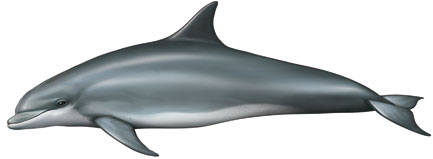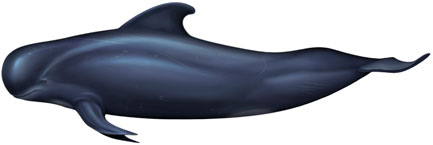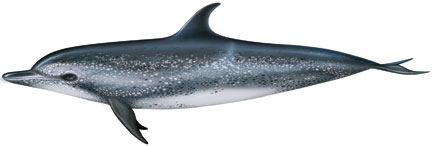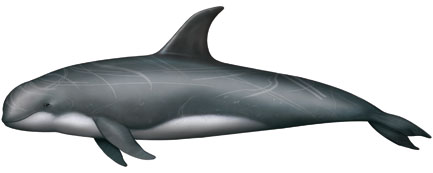Species
These waters are home to up to 21 different species, from the great blue whale to the formidable orca. Telling one species from another in the open sea and with the naked eye can be tricky, especially when they are not close to the boat. However, there are certain aspects we can focus on to help us identify the species we are looking at: size, the shape of the head, the dorsal fin, the body and tail, the colour of the body and their behaviour.
Resident species: All year round in a fixed area
 Bottlenose dolphin (Tursiops truncatus)This is the most well-known species of dolphin and can easily be spotted just off the coast of Tenerife. Their average length is 2.7 metres (8.8 feet) for males and 2.5 metres (8.2 feet) for females, with the oldest individuals measuring over 3 metres (10 feet). They live in groups of 10 to 30 members known as pods and their backs are a dark grey colour which grows gradually lighter towards the belly.
Bottlenose dolphin (Tursiops truncatus)This is the most well-known species of dolphin and can easily be spotted just off the coast of Tenerife. Their average length is 2.7 metres (8.8 feet) for males and 2.5 metres (8.2 feet) for females, with the oldest individuals measuring over 3 metres (10 feet). They live in groups of 10 to 30 members known as pods and their backs are a dark grey colour which grows gradually lighter towards the belly. Short-finned pilot whale (Globicephala macrorinchus)It is also known as the pilot whale and belongs to the Delphinidae family. This toothed cetacean (Odontoceti) owes its classification as a whale to its size: it can grow to well over 5 metres (16 feet) long and weigh between 900 and 1,800 kg (1 to 2 tons). This is the easiest species to come across on a whale watching outing in Tenerife.
Short-finned pilot whale (Globicephala macrorinchus)It is also known as the pilot whale and belongs to the Delphinidae family. This toothed cetacean (Odontoceti) owes its classification as a whale to its size: it can grow to well over 5 metres (16 feet) long and weigh between 900 and 1,800 kg (1 to 2 tons). This is the easiest species to come across on a whale watching outing in Tenerife.
Occasional visitors: All year round at unspecified frequencies
 Atlantic spotted dolphin (Stenella frontalis)This species can be identified by the spots that cover most of their skin once they reach adulthood. They form large pods and are very active. They are most often spotted between autumn and late spring. Weight: 60-80kg (130-175 lbs). Length: up to 2.3 metres (7.5 feet).
Atlantic spotted dolphin (Stenella frontalis)This species can be identified by the spots that cover most of their skin once they reach adulthood. They form large pods and are very active. They are most often spotted between autumn and late spring. Weight: 60-80kg (130-175 lbs). Length: up to 2.3 metres (7.5 feet). Rough-toothed dolphin (Steno bredanensis)The ridges and wrinkles on their teeth and their long heads are the most significant features of this species. They are darker than bottlenose dolphins and have light spots on their skin. They group together in pods of 6 to 10 members. Weight: up to 150kg (330 lbs). Length: up to 2.7 metres (8.8 feet).
Rough-toothed dolphin (Steno bredanensis)The ridges and wrinkles on their teeth and their long heads are the most significant features of this species. They are darker than bottlenose dolphins and have light spots on their skin. They group together in pods of 6 to 10 members. Weight: up to 150kg (330 lbs). Length: up to 2.7 metres (8.8 feet). Bryde's whale (Balaenoptera edeni)It is similar in appearance to the sei whale, though the Bryde's whale is smaller and more robust, featuring a characteristic that is unique to this family: three ridges on the top of its head as opposed to one central ridge. Male specimens measure 13.7 metres (45 feet), while females measure 14.5 metres (47.5 feet) and can reach up to 15 metres (49 feet). Their backs are a dark bluish-grey to metallic grey colour, with slightly lighter sides and an even lighter throat and belly.
Bryde's whale (Balaenoptera edeni)It is similar in appearance to the sei whale, though the Bryde's whale is smaller and more robust, featuring a characteristic that is unique to this family: three ridges on the top of its head as opposed to one central ridge. Male specimens measure 13.7 metres (45 feet), while females measure 14.5 metres (47.5 feet) and can reach up to 15 metres (49 feet). Their backs are a dark bluish-grey to metallic grey colour, with slightly lighter sides and an even lighter throat and belly. Striped dolphin (Stenella coeruleoalba)With its bluish colour and stripes that run from its eyes almost down to its tail, this dolphin is very easy to identify. They often steer clear of boats but they are fast swimmers and you might glimpse them jumping out of the water. Weight: 100-130 kg (220-285 lbs). Length: 2.7 metres (8.8 feet).
Striped dolphin (Stenella coeruleoalba)With its bluish colour and stripes that run from its eyes almost down to its tail, this dolphin is very easy to identify. They often steer clear of boats but they are fast swimmers and you might glimpse them jumping out of the water. Weight: 100-130 kg (220-285 lbs). Length: 2.7 metres (8.8 feet). Risso's dolphin (Grampus griseus)Morphologically, this mammal is very similar to the pilot whale but its skin is grey in colour, or even closer to white in some adult specimens, which contrasts with the dark colour of its dorsal fin. Weight: 300-600kg (660-1320 lbs).
Risso's dolphin (Grampus griseus)Morphologically, this mammal is very similar to the pilot whale but its skin is grey in colour, or even closer to white in some adult specimens, which contrasts with the dark colour of its dorsal fin. Weight: 300-600kg (660-1320 lbs). Sperm whale (Physeter macrocephalus)This species is the largest of the Odontoceti family and is as big as most whales. Its most notable features are its huge head, grooved dark skin and small dorsal fin. It can go for more than an hour without breathing in order to find food at depths of over 2,000 metres (6,500 feet). They are most often seen in springtime. Weight: 13,500-54,000 kg (15-60 tons). Length: 11-18 metres (36-59 feet).
Sperm whale (Physeter macrocephalus)This species is the largest of the Odontoceti family and is as big as most whales. Its most notable features are its huge head, grooved dark skin and small dorsal fin. It can go for more than an hour without breathing in order to find food at depths of over 2,000 metres (6,500 feet). They are most often seen in springtime. Weight: 13,500-54,000 kg (15-60 tons). Length: 11-18 metres (36-59 feet).
Seasonal/migratory species: Visible at some times of the year
 Common dolphin (Delphinus delphis)The common dolphin can be found in most of the planet's oceans. It is easy to identify due to the special yellow markings on its sides. They are most often seen in winter. Weight: 80-130 kg (175-285 lbs). Length: up to 2.5 metres (8.3 feet).
Common dolphin (Delphinus delphis)The common dolphin can be found in most of the planet's oceans. It is easy to identify due to the special yellow markings on its sides. They are most often seen in winter. Weight: 80-130 kg (175-285 lbs). Length: up to 2.5 metres (8.3 feet). Common rorqual (Balaenoptera physalus)Also known as the fin whale, its most prominent feature are its markings. The top and sides of the body are black or a dark greyish-brown, which fades gradually into white on the belly. The colour of the head, however, is asymmetrical. The right side of its face is light grey with a white jaw, matching the colouring of the throat and belly. The left side of its face is darker, with a dark grey jaw and throat. It also has a series of colour markings across the width of its back, behind its head, the most distinctive being shaped like an upside-down V, which is more visible on the right side.
Common rorqual (Balaenoptera physalus)Also known as the fin whale, its most prominent feature are its markings. The top and sides of the body are black or a dark greyish-brown, which fades gradually into white on the belly. The colour of the head, however, is asymmetrical. The right side of its face is light grey with a white jaw, matching the colouring of the throat and belly. The left side of its face is darker, with a dark grey jaw and throat. It also has a series of colour markings across the width of its back, behind its head, the most distinctive being shaped like an upside-down V, which is more visible on the right side. Sei whale (Balaenoptera borealis)Male sei whales can measure up to 17.1 metres (56 feet), while females reach up to 18.6 metres (61 feet) and can weigh as much as 25,000 kg (25 tons). They are similar to the Bryde's whale but bigger, darker and more slender, and with a single ridge on their head. The proportion of the head is similar to that of the Bryde's whale, ranging from 1/4 to 1/5 of its total length, but looks narrower from above and has a well-defined ridge. The overall colouring is dark grey or brown, almost black, often resembling galvanised metal, except on the belly, which has a white colouring that varies in size.
Sei whale (Balaenoptera borealis)Male sei whales can measure up to 17.1 metres (56 feet), while females reach up to 18.6 metres (61 feet) and can weigh as much as 25,000 kg (25 tons). They are similar to the Bryde's whale but bigger, darker and more slender, and with a single ridge on their head. The proportion of the head is similar to that of the Bryde's whale, ranging from 1/4 to 1/5 of its total length, but looks narrower from above and has a well-defined ridge. The overall colouring is dark grey or brown, almost black, often resembling galvanised metal, except on the belly, which has a white colouring that varies in size. False killer whale (Pseudorca crassidens)This cetacean has a slender body and a dorsal fin that can measure up to 30 cm (a foot) high. Two of its most distinctive features are the bend and elbow-like bulge half way along each of its flippers. The false killer whale is dark grey to black all over. It can grow to up to 6 metres (19.6 feet), weigh up to 1,500 kg (1.5 tons) and live as long as 60 years. They are sociable animals who live in pods of 10 to 50 members.
False killer whale (Pseudorca crassidens)This cetacean has a slender body and a dorsal fin that can measure up to 30 cm (a foot) high. Two of its most distinctive features are the bend and elbow-like bulge half way along each of its flippers. The false killer whale is dark grey to black all over. It can grow to up to 6 metres (19.6 feet), weigh up to 1,500 kg (1.5 tons) and live as long as 60 years. They are sociable animals who live in pods of 10 to 50 members.
Rarely-seen species
- Blainville's beaked whale (Mesoplodon densirostris)
- Cuvier's beaked whale (Ziphius cavirostris)
- Gervais' beaked whale (Mesoplodon densirostris)
- Pygmy sperm whale (Kogia breviceps)
- Fraser's dolphin (Lagenodelphis hosei)
- Blue whale (Balaenoptera musculus)
- Humpback whale (Megaptera novaeangliae)
- Common minke whale (Balaenoptera acutorostrata)
- Orca (Orcinus orca)